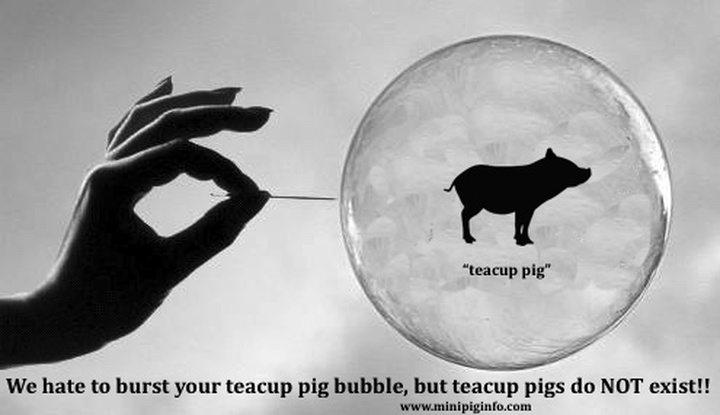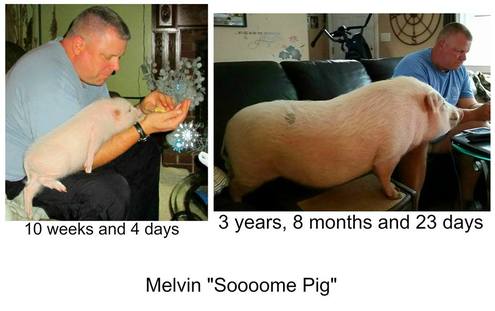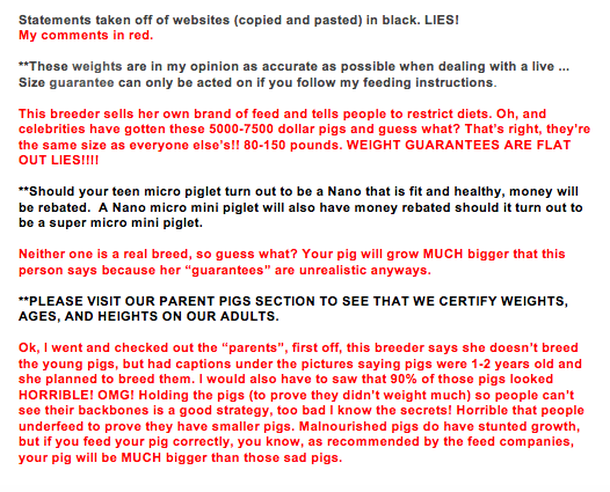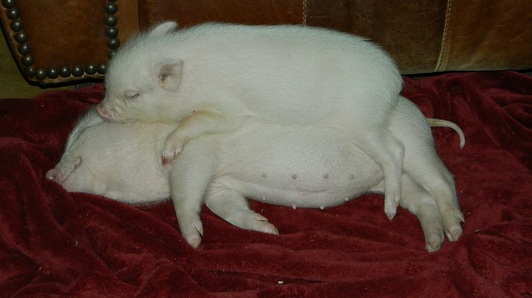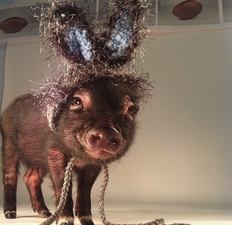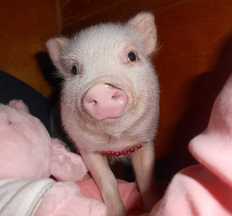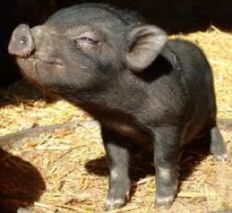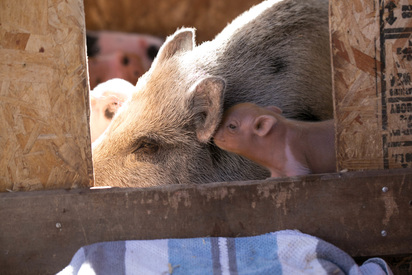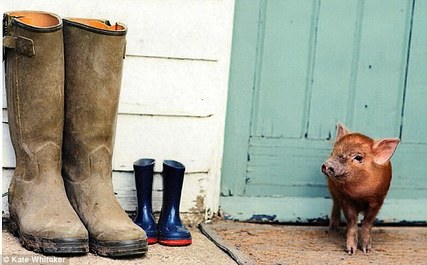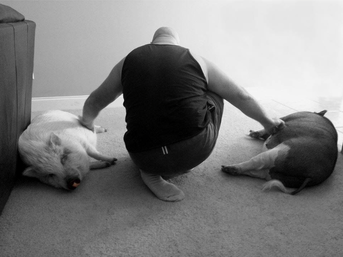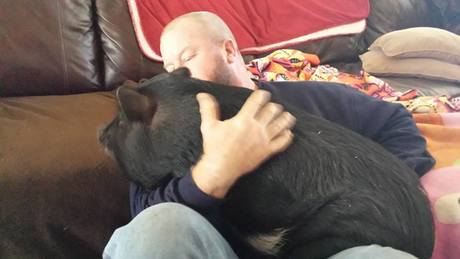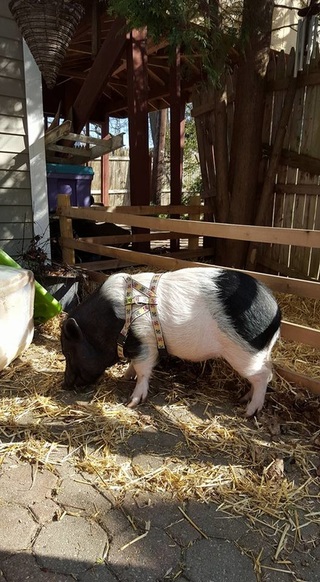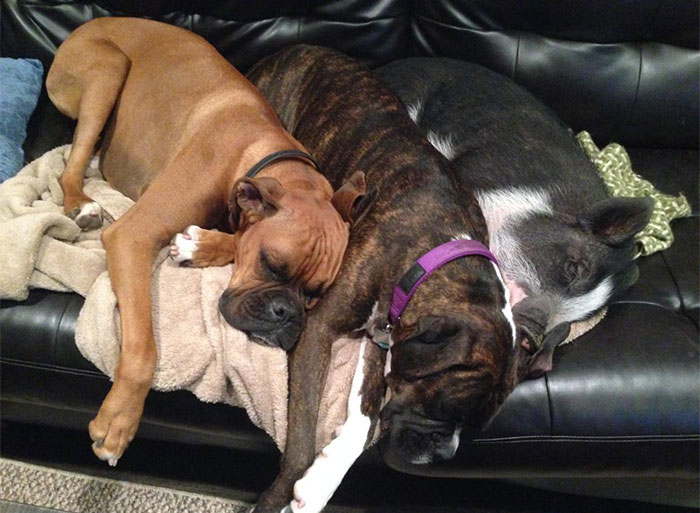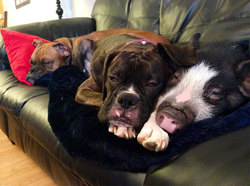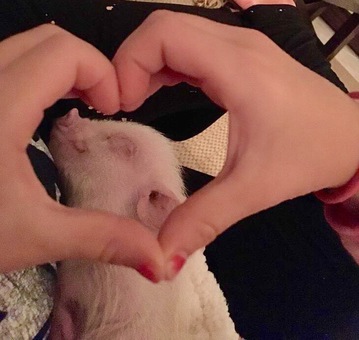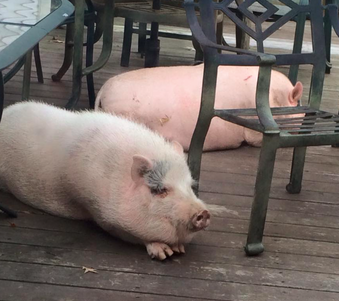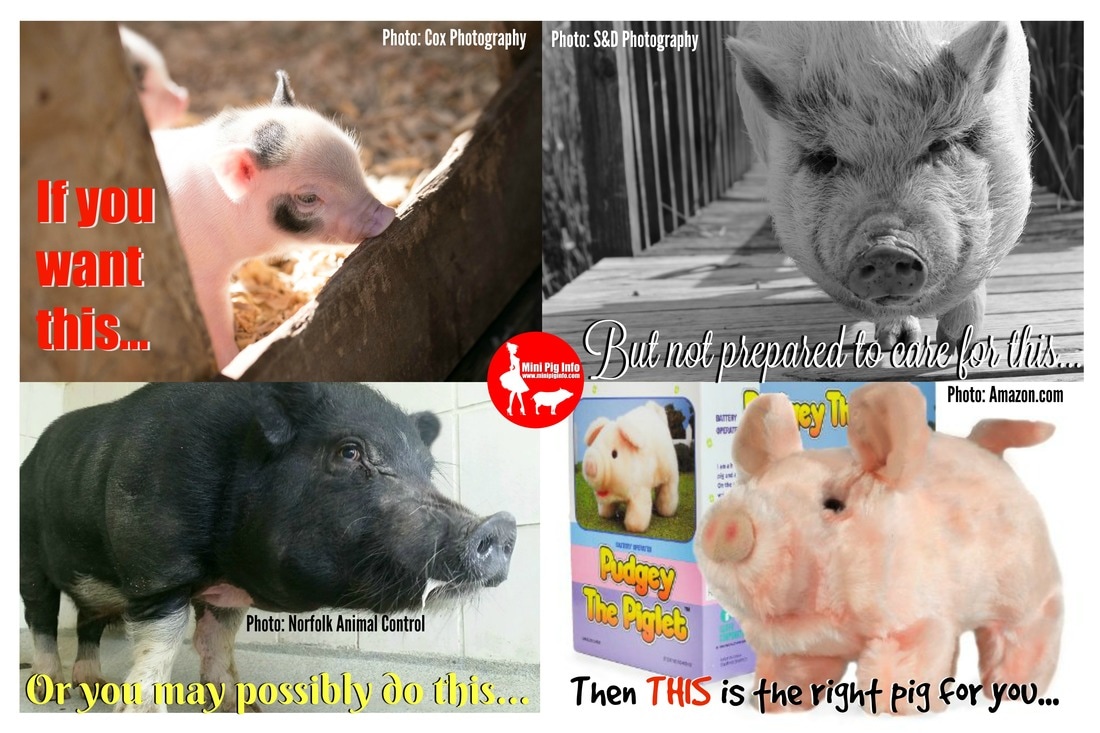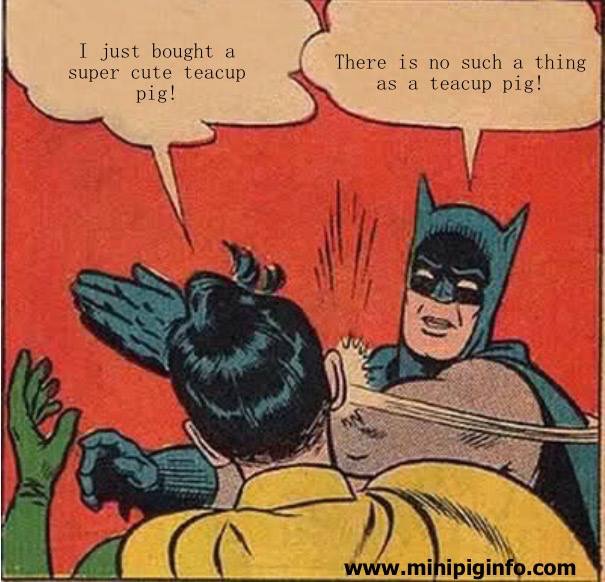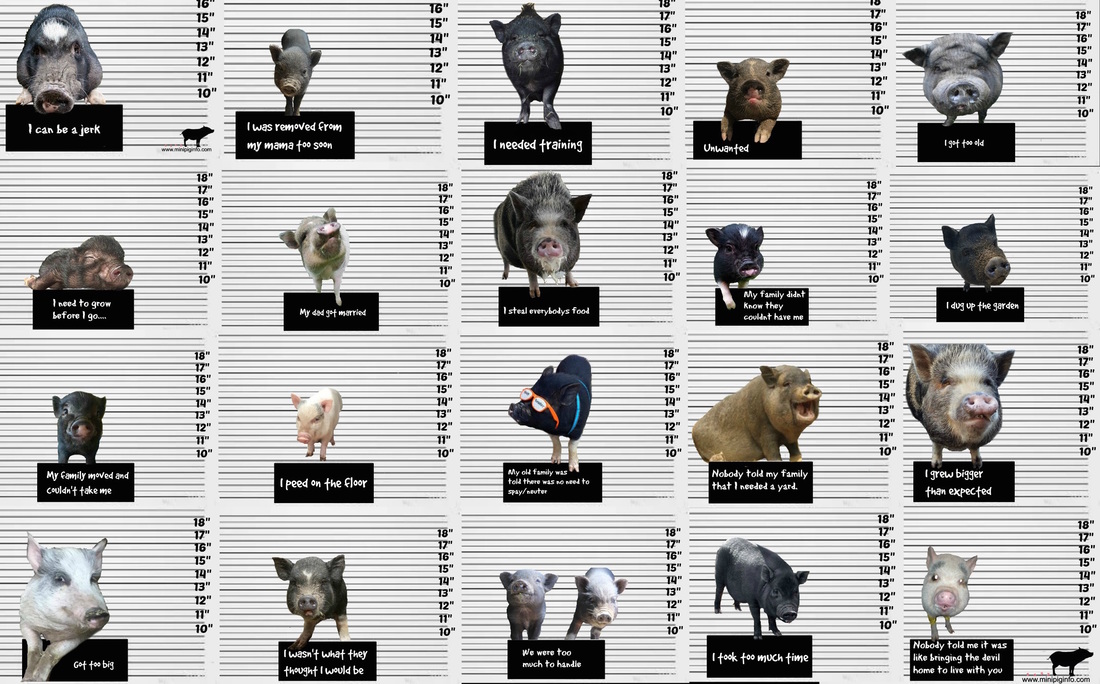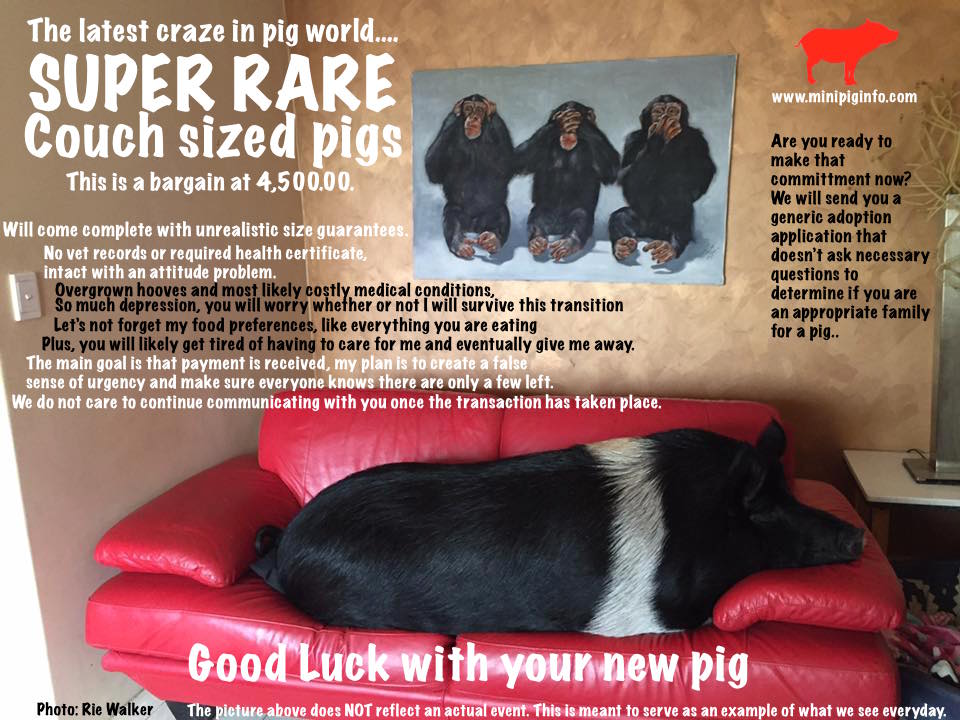The small pig MYTH. The teacup pig, micro pig, micro mini pig, nano pig, dandy pig, pocket pig, genetically altered pig, apartment pig, designer pig, guaranteed to stay under 25 pound MYTH!
There are no breeds with names like teacup pig, micro pig, or any of the other fancy names like nano pig, pocket pig, or apartment pig. These terms are not actual breeds or factual descriptions. Instead, they are marketing gimmicks designed to make you think that a particular pig will stay small forever, which is not true.
These misleading terms often imply that the pigs will remain small enough to fit into a teacup, but that is simply not the case.
Our goal is to save even one pig from being abandoned because it grew much larger than expected. By spreading this information, we hope to prevent families from getting a pig without understanding the reality of their growth. The term "mini" refers to a class of pigs that are smaller than standard farm pigs, but it is not a breed. Even this term can be misleading, as "mini" can apply to various sizes of pigs.
Pigs are often misrepresented due to their variety in shapes, sizes, and colors. There is a lack of educational resources, knowledgeable veterinarians, and a market of people genuinely interested in their well-being. I am not a pig breeder or a pig rescue. I have one pet pig and no financial interest in promoting any particular breed or size of pig. My aim is purely educational, based on my experiences and observations of others who have been misled by these marketing terms.
While there are smaller-statured pigs, their overall health can be questionable. Without access to their vet records, it's hard to determine if they have genetic defects or health issues. Most "pet pigs" are a mix of various breeds. The original purebred potbellied pigs introduced to the U.S. in the 1980s have since been interbred, and there is no way to track their lineage today.
Breeders cannot guarantee the size of a pig based on its parents' size. We have a page on our website showing realistic sizes of "mini pigs" as shared by our followers. Some of these pigs, sold as "micro pigs" or "teacup pigs" for over $3,000, grew much larger than expected.
Here is a clip from Dr. Jeff: Rocky Mountain Vet, explaining that most mini pigs, teacup pigs, or micro pigs will reach between 100-150 pounds. In the video, he examines a pig with crippling arthritis, highlighting how weight distribution affects joints and leads to arthritis. Watch the video.
These misleading terms often imply that the pigs will remain small enough to fit into a teacup, but that is simply not the case.
Our goal is to save even one pig from being abandoned because it grew much larger than expected. By spreading this information, we hope to prevent families from getting a pig without understanding the reality of their growth. The term "mini" refers to a class of pigs that are smaller than standard farm pigs, but it is not a breed. Even this term can be misleading, as "mini" can apply to various sizes of pigs.
Pigs are often misrepresented due to their variety in shapes, sizes, and colors. There is a lack of educational resources, knowledgeable veterinarians, and a market of people genuinely interested in their well-being. I am not a pig breeder or a pig rescue. I have one pet pig and no financial interest in promoting any particular breed or size of pig. My aim is purely educational, based on my experiences and observations of others who have been misled by these marketing terms.
While there are smaller-statured pigs, their overall health can be questionable. Without access to their vet records, it's hard to determine if they have genetic defects or health issues. Most "pet pigs" are a mix of various breeds. The original purebred potbellied pigs introduced to the U.S. in the 1980s have since been interbred, and there is no way to track their lineage today.
Breeders cannot guarantee the size of a pig based on its parents' size. We have a page on our website showing realistic sizes of "mini pigs" as shared by our followers. Some of these pigs, sold as "micro pigs" or "teacup pigs" for over $3,000, grew much larger than expected.
Here is a clip from Dr. Jeff: Rocky Mountain Vet, explaining that most mini pigs, teacup pigs, or micro pigs will reach between 100-150 pounds. In the video, he examines a pig with crippling arthritis, highlighting how weight distribution affects joints and leads to arthritis. Watch the video.
People make up names as they go along, based on what people are searching for. If there are an abundance of people searching for teacup pigs, then some breeders will have teacup pigs. If a popular search is micro pig, then breeders will use those terms to describe their pigs and advertise micro pigs for sale. This sets potential pig parents up for huge disappointments. Often times, they're not equipped or ready for a pig that may grow to be 200lbs, so when these pigs start getting bigger and bigger, statistics say 90% of pet pigs are rehomed before their 1st birthday. I'm not sure how accurate this percentage is, but based on the amount of pigs I see on craigslist or social media where someone is desperately searching for a new home for their pig or networking pigs in shelters, I would have to agree the number is likely high. Another common ploy is to pass a pig off as a much older pig when advertised/sold. There have been cases when pigs were said to be 6 months or older, leading people to believe that this pig was smaller framed only to later find out...LIE. Pigs have suffered horribly because of these lies. I remember one pig family whose pig passed away during a spay which they scheduled based on the fact the pig was 6 months old, but in reality, she was only 3-4 weeks old. Granted, an inexperienced vet should have known better and is also at fault because they weren't able to identify a much younger pig, but nonetheless, the piglet still paid the ultimate price with her life.
Inaccurate terms used to describe mini pigs
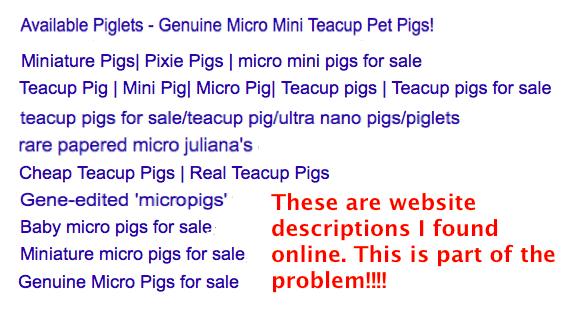
Out of these ads for pigs, the only one that is truthful is the miniature pigs for sale, but they ruin that by adding on all the other inaccurate/deceiving/misrepresenting terms. Using "mini" or "miniature" has become the standard for use to describe pigs smaller than their cousin, the farm pig as a way to distinguish the difference between the two.
On the next page of the website, we have a list of pigs that are true BREEDS, not made up names. Click here to read about actual breeds of pigs typically seen as pets. Do not get this confused with pedigreed animals. Pedigreed animals have a record of their genetic history. The domesticated pigs and wild breeds have been bred, the different true breeds of pigs have been bred together, daughters have bred with fathers or brothers, mothers with sons, etc...Odds are, that information will not be advertised with the descriptive terms. The problem is, this creates genetic abnormalities. Inbreeding helps breeders fix specific traits in a particular group of pigs. The limited gene-pool caused by continued inbreeding means that deleterious genes become widespread and the breed loses vigour. Laboratory animal suppliers depend on this to create uniform strains of animal which are immuno-depressed or breed true for a particular disorder e.g. epilepsy. But we are not using pet pigs for research, so we do not need constant or fixed traits in our pigs. The inbreeding causes medical issues as well, again, this will not be advertised when you are being sold a piglet. There is a formula scientists use to track inbreeding. This is the formula listed on one of the university sites as one they use to determine the inbreeding coefficiency. The general formula for an inbreeding coefficient is as follows:
F =∑ [(1/ ) n+1(1+F )]
I am not a scientist, so I have no idea how that works, I only know of the after effects. Picking the "runt", possibly underfeeding to stunt the growth and using that pig as a "breeder" pig is usually how this starts. A known effect of inbreeding is that there is typically a % of decreased size that is achieved. However, these pigs are predisposed to inherit undesirable traits as well as whatever specific gene that breeder hopes to pass along. Many disorders are KNOWN to be the result of sloppy inbreeding, such as, leg defects, cryptorchidism (born with one or more undescended testicles), atresia ani (born without a rectal opening), umbilical hernia, scrotal hernia, rendement napole (lower muscle pH, paler color, lower protein extractability), porcine stress syndrome, tremors, cleft palate, hemophilia, hydrocephalus, motor neuron disease, rectal prolapse, idiopathic seizures, musculoskeletal disorders, heart disease and brain hernia's are just a few of the undesirable traits that may be passed on due to inbreeding. This is a very small list of inherited conditions that can be difficult to manage and sometimes downright expensive, if possible to treat at all. There are so many possibilities for bad traits that can be passed on, however, because breeders are using such young pigs as their breeder pigs, typically so they have a small pig to show you as the grown or mature "parent" pig, they aren't even aware of the disadvantages these piglets may have because their breeder pig hasn't had a chance to exhibit the effects of these same undesirable traits passed along to your piglet. It is a vicious cycle. In most countries, incest is a crime and usually punishable by prison time. Why would it be ok to do this with our pigs? Human studies know the bad effects of inbreeding, thus a law was put in effect to deter this behavior and a punishment for violation. There are known mutations in the genetic make up due to inbreeding, so this shouldn't be something people are aiming to do in order to achieve a smaller pig or a specific trait. There are far too many bad possibilities and disadvantages to think that this should be a best practice.
Small pigs do exist. (VERY FEW, like a handful out of the 100,000's of pet pigs out there) Are they healthy? Who knows? There hasn't been a breeder that has been able to CONSISTENTLY produce a small pig though. Every once in a while there may be one that is tiny compared to everyone else's but that seems to be a fluke, not a consistent pattern in their pigs they produce. Healthy pigs live to be an average of 15-20 years old, some slightly less, some slightly more. We see pigs on social media everyday who have multiple comorbidities...is this from inbreeding? Again, who knows...but since a lot of the underlying issues are known to be inherited traits, my educated guess would be yes. There have been an enormous amounts of younger pigs dying recently. This may be because the pig community has more of a social presence now; whereas it was extremely limited in the past, so we hear about it more, OR, there very well may more pigs suffering the effects of something, possibly the effects of inbreeding. I do know that scientists haven't been able to produce or "breed down" to a healthy pig less than 60lbs in the research world and this is with a VERY strict diet and resources that the general public doesn't have access to nor understand. Why would you think someone without a degree in genetics could possibly do better than that? One of the problems is the media coverage. I have seen news stories aired that represented a pig as a micro or teacup and also big name companies use a piglet to their advantage in commercials or ads compounding the existing novelty teacup pig trend. For an investigative reporter to go on air and having not done their own research and use these terms as facts is obnoxiously ignorant. And quite frankly, makes a lot of people in pig world upset who have to chime in to the "OMG! I want a teacup pig" comments to shed some light and share the truth. Day after day it happens, it may even be an old story that is "new" again, being shared all over the place and reigniting that old burnt out flame, but unfortunately, there isn't much you can do about it other than try your best to educate.
Teacup pigs do NOT exist, Micro pigs do NOT exist, neither do any of the other marketing terms. So what about those who have a weight "guarantee", a promise that this specific pig will not grow past a certain weight? Let me ask you a question, did you see a genetic degree hanging on their wall? If not, they can not predict how big your pig will be. One common thing I have seen is that people grow very attached to their pet pig(s), the breeder is counting on that. Would you ever send a pig back to a breeder after having lived with you for a year because your pig now weighs 80lbs and outgrew that 20lb promise? Odds are, no. You love THIS pig and do not want that pig to go anywhere, so you adjust and adapt. However, some people are not able to make adjustments and accommodate a bigger pig. Some live in second story apartments (that's another problem altogether) and their pig cannot maneuver the stairs to be able to go outside. Some live in areas that have ordinances that contain weight limits for pigs. While I disagree with their theory and feel like they should not promote starving pigs to fit their guidelines, I do understand there has to be limits. That is also why I have a problem with these terms being used to describe these pigs. That is why we have 1000's of unwanted and homeless pigs at rescues, shelters, on craigslist, on facebook or twitter or yard sale ads because the pig parents can't handle the pig or don't want the responsibility, weren't prepared to care for a pig to begin with, or whatever the excuse may be. Even if you did decide to send the pig back, will the breeder take the pig back? Are you able to ship the pig back? Do you know how much it would be to ship a 100lb, live animal back to the breeder? All things you should consider before getting a pig.
F =∑ [(1/ ) n+1(1+F )]
I am not a scientist, so I have no idea how that works, I only know of the after effects. Picking the "runt", possibly underfeeding to stunt the growth and using that pig as a "breeder" pig is usually how this starts. A known effect of inbreeding is that there is typically a % of decreased size that is achieved. However, these pigs are predisposed to inherit undesirable traits as well as whatever specific gene that breeder hopes to pass along. Many disorders are KNOWN to be the result of sloppy inbreeding, such as, leg defects, cryptorchidism (born with one or more undescended testicles), atresia ani (born without a rectal opening), umbilical hernia, scrotal hernia, rendement napole (lower muscle pH, paler color, lower protein extractability), porcine stress syndrome, tremors, cleft palate, hemophilia, hydrocephalus, motor neuron disease, rectal prolapse, idiopathic seizures, musculoskeletal disorders, heart disease and brain hernia's are just a few of the undesirable traits that may be passed on due to inbreeding. This is a very small list of inherited conditions that can be difficult to manage and sometimes downright expensive, if possible to treat at all. There are so many possibilities for bad traits that can be passed on, however, because breeders are using such young pigs as their breeder pigs, typically so they have a small pig to show you as the grown or mature "parent" pig, they aren't even aware of the disadvantages these piglets may have because their breeder pig hasn't had a chance to exhibit the effects of these same undesirable traits passed along to your piglet. It is a vicious cycle. In most countries, incest is a crime and usually punishable by prison time. Why would it be ok to do this with our pigs? Human studies know the bad effects of inbreeding, thus a law was put in effect to deter this behavior and a punishment for violation. There are known mutations in the genetic make up due to inbreeding, so this shouldn't be something people are aiming to do in order to achieve a smaller pig or a specific trait. There are far too many bad possibilities and disadvantages to think that this should be a best practice.
Small pigs do exist. (VERY FEW, like a handful out of the 100,000's of pet pigs out there) Are they healthy? Who knows? There hasn't been a breeder that has been able to CONSISTENTLY produce a small pig though. Every once in a while there may be one that is tiny compared to everyone else's but that seems to be a fluke, not a consistent pattern in their pigs they produce. Healthy pigs live to be an average of 15-20 years old, some slightly less, some slightly more. We see pigs on social media everyday who have multiple comorbidities...is this from inbreeding? Again, who knows...but since a lot of the underlying issues are known to be inherited traits, my educated guess would be yes. There have been an enormous amounts of younger pigs dying recently. This may be because the pig community has more of a social presence now; whereas it was extremely limited in the past, so we hear about it more, OR, there very well may more pigs suffering the effects of something, possibly the effects of inbreeding. I do know that scientists haven't been able to produce or "breed down" to a healthy pig less than 60lbs in the research world and this is with a VERY strict diet and resources that the general public doesn't have access to nor understand. Why would you think someone without a degree in genetics could possibly do better than that? One of the problems is the media coverage. I have seen news stories aired that represented a pig as a micro or teacup and also big name companies use a piglet to their advantage in commercials or ads compounding the existing novelty teacup pig trend. For an investigative reporter to go on air and having not done their own research and use these terms as facts is obnoxiously ignorant. And quite frankly, makes a lot of people in pig world upset who have to chime in to the "OMG! I want a teacup pig" comments to shed some light and share the truth. Day after day it happens, it may even be an old story that is "new" again, being shared all over the place and reigniting that old burnt out flame, but unfortunately, there isn't much you can do about it other than try your best to educate.
Teacup pigs do NOT exist, Micro pigs do NOT exist, neither do any of the other marketing terms. So what about those who have a weight "guarantee", a promise that this specific pig will not grow past a certain weight? Let me ask you a question, did you see a genetic degree hanging on their wall? If not, they can not predict how big your pig will be. One common thing I have seen is that people grow very attached to their pet pig(s), the breeder is counting on that. Would you ever send a pig back to a breeder after having lived with you for a year because your pig now weighs 80lbs and outgrew that 20lb promise? Odds are, no. You love THIS pig and do not want that pig to go anywhere, so you adjust and adapt. However, some people are not able to make adjustments and accommodate a bigger pig. Some live in second story apartments (that's another problem altogether) and their pig cannot maneuver the stairs to be able to go outside. Some live in areas that have ordinances that contain weight limits for pigs. While I disagree with their theory and feel like they should not promote starving pigs to fit their guidelines, I do understand there has to be limits. That is also why I have a problem with these terms being used to describe these pigs. That is why we have 1000's of unwanted and homeless pigs at rescues, shelters, on craigslist, on facebook or twitter or yard sale ads because the pig parents can't handle the pig or don't want the responsibility, weren't prepared to care for a pig to begin with, or whatever the excuse may be. Even if you did decide to send the pig back, will the breeder take the pig back? Are you able to ship the pig back? Do you know how much it would be to ship a 100lb, live animal back to the breeder? All things you should consider before getting a pig.
Micro pig myth in the news
Micro pigs for sale and the inaccurate info found online
We can post link after link with regards to people being deceived into buying a nonexistent breed of pig, but the fact remains that people still do it despite the massive amount of information that should cast at least a doubt in their minds. We see it day after day after day. People complaining their pig isn't a teacup (big surprise there) or others saying they just got a micro mini pig (which is also not a breed of pig). These people are setting themselves up for a huge disappointment. If you should see anyone posting information about teacup pigs, share some links to credible websites that will show them the truth. We have a page that literally has pictures of real pigs and their sizes and ages for people to be able to see for themselves that pigs grow. And some grow much bigger than they'd expect. You don't have to be rude to get the message across to them. There is a nice way to say anything and remember people can't hear the sincerity that they normally would by listening to you talk, its much harder to read people when reading a comment. Here is an article Consumer Affairs put out about pet pigs.
Consumer Affairs warning:
https://www.consumeraffairs.com/news/do-your-research-before-buying-a-teacup-pig-or-mini-potbellied-pig
Consumer Affairs warning:
https://www.consumeraffairs.com/news/do-your-research-before-buying-a-teacup-pig-or-mini-potbellied-pig
Most pigs will weigh somewhere between 80-160lbs at maturity. Maturity is around 5 years old, although some say its 3 years old. Pigs have several growth spurts and they're ALL different. Different shapes, sizes, temperaments, dispositions, color, height, length, eye color, hair length, etc. And that can be the differences in the same litter of pigs!! Based on the veterinarians general rule of thumb that healthy pigs should gain a pound a week for the for year, that information trumps anything a breeder says. So at the very minimum, thats 52lbs. And that is only the first year, there is 2-4 more years of growing to do. Not to mention, if you're not feeding a balanced diet, meaning feeding the appropriate amount and type of food for your pigs specific caloric needs, your pig will keep getting fatter and fatter until he/she is morbidly obese. If you are not feeding enough for your pigs specific caloric needs, your pig will likely suffer the major effects of malnutrition and/or death (click here to read our log about malnourished pigs). You can read more about nutrition by clicking here. Do NOT feed a brand of food that you aren't able to verify is appropriate for a pet pig. The latest "craze" is breeders coming up with their own formulary of food, God only knows what is in it because there are no labels listing ingredients, so ultimately, you have NO idea what you're feeding your pig! Is this harming your pig? Are the essential vitamins and minerals balanced like they're supposed to be? What is the feed? If you cant answer these questions, you should really reconsider the diet choices. Can you possibly stunt the growth of a pig by NOT feeding the pig correctly? Sure you can, but, you likely won't enjoy that pig for long because the pig will probably not have enough energy to play like normal pigs or die from malnutrition at a much younger age than normal. Don't trust someone who has already lied to you by saying they have teacup or micro pigs to begin with.
All of these pigs are super cute, no doubt...however, they will ALL grow much bigger. They don't stay small or piglet sized. They can't fit in your purse or a pet bag after several months. But when you see pictures like this? You have no idea that you'll end up with a pet pig that is nowhere near this size. Still cute? ABSOLUTELY! Just because your pig weighs more than 40 pounds doesn't mean your pig isn't cute. Pigs are rather dense animals, so their weight isn't a good description of what they actually look like. Most people are going to height now as a way to market sizes of pigs. Some finally realized that they can't control what you feed your pig, therefore they cannot predict how much your pig will weigh. Common sense really. Using my height of 5'2" as a reference, from the floor to my kneecap is 16". My pig does NOT come up to my kneecap, so her height is 15". (I just measured her height to write this article). Does this mean she is a small dainty pig? No, it doesn't. My pig is a big girl actually. (Partially my fault and we are working on it) So, height doesn't really mean anything either. A pig can be slimmer or fuller and by estimating the height of your fully grown pig? That doesn't imply that your pig will be big or small. GENETICS is what determines your pigs size, not a promise, not a breeder, not a chart...it is your pigs DNA that determines how big your pig will get.
Piglet compared to the sow. As you can see, there is a significant size difference and note the varying colors in the piglets.
Cute piglet, standing by a set of child and man's boots. This particular picture comes from an article which you can read in full here claiming pigs are the latest fad and "micro" in size. These kinds of articles are one of the reasons people believe that pigs stay small. http://www.dailymail.co.uk/Pig-tales-Meet-house-trained-micro-pigs
How photo's can misrepresent sizes of mini pigs
For comparative purposes, this is two older pigs getting belly rubs by their pig dad. Keith is not a small man, rather tall, healthy...note that relative to size, these pigs look rather small. (they're also laying down) The second picture is a better example of the actual size though. Same man, same pig.
This is Michelle Grimes pig child. Note the cooler to the left of this pig as it relates to the overall size. This big is neither fat, nor skinny. Plenty of clearance between the belly and ground, hip bones are not sticking out and there is not an enormous amount of fat on this pig. This is an ideal size. This pig is NOT fully grown, but an ideal size.
|
I do not know the age of this pig, but as you can see, in relation to the size of her dog friends, she is not substantially larger in body size. She may weigh more, but her body size is not bigger than her canine companions. (We do NOT endorse or support leaving dogs and pigs together unsupervised. Click here to read more about the dangers of pigs and digs)However, pigs are more dense animals and typically weigh more in pounds than animals that are of equal size.
|
The purpose of this page is to inform you that there are no breeds of pigs called teacup, micro, micro mini, designer, apartment, even mini pig...these are all terms used to describe pigs, but not usually accurate when it comes to describing their adult size. Do not buy into the lies, teacup pigs are not a real size. If you want to know how big a pig will be when grown, adopt an older more mature pig. Visit a pig rescue and see how many "teacup" pigs they have. (You can click here to see a list of pig rescues) We encourage people to visit a pig rescue before adding a pig to the family regardless, this way you can see for yourself what life is REALLY like with a pet pig. Not the skewed version you see posted by others with dresses and painted hooves. Although that is cute, its unrealistic and creates a glamourous view of pet pigs which is often not the case. And finally, if size is that significant to you, a pet pig likely is NOT a good choice for you. Pigs come in all sizes and shapes and you honestly never know what you're getting. Do NOT get a pig if space is an issue or you aren't allowed to have a pet with weight restrictions. Your pig will likely outgrow restrictions based on normal domestic pet sizes. Continue to read and research before making your decision, know pigs aren't like other pets and you may have zoning issues or no outside space, which they need. Please do not get a pig on a whim, everyone is overflowing with pigs. Adopt, rescue, or foster a pig in need before spending a ton of money to get a pig that will likely be the same size.
Written by Brittany Sawyer
June 5th 2015
To read more about genetic dwarfism, written by the Journal of Pharmacological and Toxicological Methods, you can download the PDF file below.
Written by Brittany Sawyer
June 5th 2015
To read more about genetic dwarfism, written by the Journal of Pharmacological and Toxicological Methods, you can download the PDF file below.
Mini Pig Dwarfism
| genetic_dwarfism.pdf |
A Pig Story: Movie by Holly McMahon
The video below was created by Holly McMahon, this video is real life with pigs, interviews with pig parents, rescue/sanctuary owners who open their homes to all these unwanted pigs. It is lengthy, but features some interviews with people you may recognize like Esther the wonder pig's dads, Steve and Derek. Video posted to the website with permission.
Most common reasons why pigs are rehomed
What if there were truth in advertising? The following picture is one you may see if facts would be told up front...

